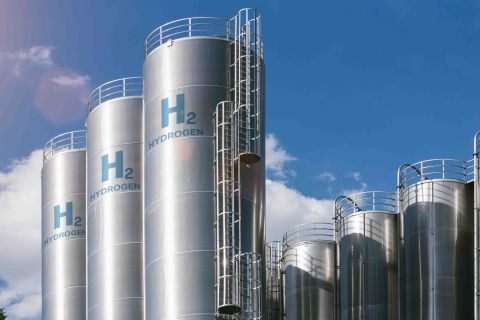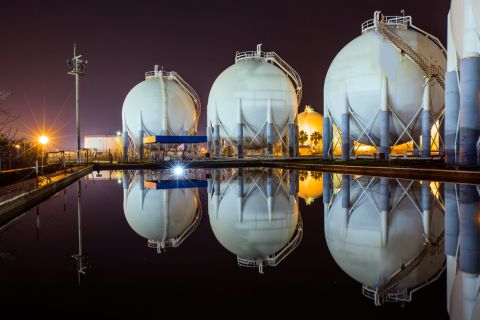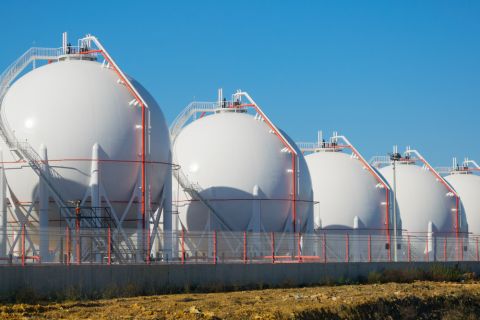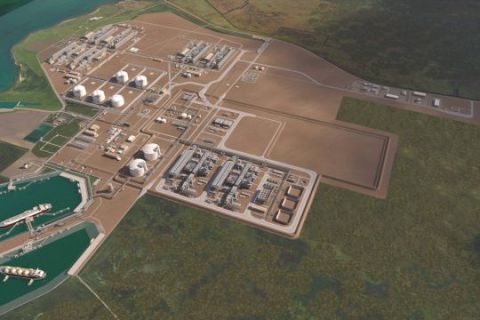Learn more about Hart Energy Conferences
Get our latest conference schedules, updates and insights straight to your inbox.
Dropping commodity prices and increasing supplies led to a surge in demand for oil and gas transport in the first quarter. In meeting that demand, midstream companies reported strong and, in some cases, record-setting earnings.
Strong international demand for LNG and NGL from 2022 continued into 2023 as production from the Permian Basin also rose, and most major players said they had already increased pipeline capacity or had projects underway to do so.
“If you want to know where we’re going, look at what we’re doing,” Jim Teague, Co-CEO of Enterprise Products Partners LP, said during his company’s earnings call. “We continue to expand our ability to export hydrocarbons out of the U.S. to points all over the world.”
Teague said he expected the commodity prices to remain range-bound for the immediate future, meaning a relatively stable market price. A mild winter across most of the U.S. allowed supply to expand, and the current profitability for transporting oil and gas has put some companies in acquisition mode.
On May 4, one industry player, Magellan Midstream Partners, reported a first-quarter net income increase of $108 million (65%) over the same quarter of 2022. Ten days later, Magellan was purchased by Tulsa, Okla.-based ONEOK Inc. Through the merger, ONEOK, a gas-transport company, will gain access to Magellan’s refined materials and crude oil pipelines.
In March, Energy Transfer agreed to a $1.45 billion cash and stock deal to purchase Lotus Midstream, which operates a pipeline system covering the major production areas of the Permian.
In February, the Williams Cos. closed the acquisition of MountainWest Natural Gas and Storage Transmission, a company network that operated out of the Rockies, serving Utah, Wyoming and Colorado. The takeover went smoothly and other expansion opportunities were potentially opening up, said Alan Armstrong, president and CEO.
Building capacity
Otherwise, companies focused on expanding their infrastructure.
Enterprise reported record pipeline and fee-based natural gas processing volumes, and record NGL and marine terminal volumes. The company plans to put projects worth $3.8 billion into service this year, including the commissioning of its second propane dehydrogenation plant, PDH 2, and the expansion of the Acadian gas pipeline system in Texas and Louisiana, respectively.
Greg Ebel, president and CEO of Enbridge Inc., announced plans to construct a blue ammonia facility at the company’s Ingleside Energy Center. Along with previously announced projects of a CCS hub at Ingleside, Ebel said the facility will become a “Swiss Army Knife terminal with its world-class oil loading capacity, on-site storage and a suite of lower carbon development and renewable power.”
Enbridge, which ships the bulk of Canadian crude that comes through the U.S., also announced an agreement in principle with shippers for tolls on its Mainline pipeline system, ensuring the company will be able to meet the expected load schedule. Crude transport on the Mainline system increased by 100,000 bbl/d over the same period last year.
The company expects demand to eat up the added capacity. More refining capacity is opening up along the Gulf Coast, while Mexico’s Pemex announced in February that it expected to increase its refining capacity up 1 MMbbl/d by the end of the year.
The increase translates into more demand for Canadian crude in the Gulf, said Colin Gruending, Enbridge’s executive vice president and president of its liquids pipeline business. Meanwhile, rail transport continues to become more expensive, making pipelines more attractive.
Enbridge is also expanding its capacity in Texas. It took over operation of the 850-mile Gray Oak pipeline in April and has boosted its capacity by 25,000 bbl/d.
Permian’s the place
The Permian Basin remains a focus for many companies trying to meet steadily increasing market demand. Most company representatives said they wanted to emphasize projects that gave them flexibility.
Targa Resources Corp. has four natural gas plants under construction in the basin and expects to order an additional two. In the first quarter, the company averaged a record 4.8 Bcf/d of reported inlet volumes.
“In Permian Midland, our system has essentially been running above nameplate capacity, absent the impact of first-quarter winter weather, and is currently operating up over 100 MMcf/d versus the Q1 average inlet,” Matt Malloy, Targa Resources CEO, said during the company’s first-quarter earnings call.
In March, the Texas Railroad Commission granted Targa a permit to build the Apex gas pipeline. The proposed 562-route pipe stretches from Midland County to Jefferson County and is designed to support future projects in the Sabine River area.
Plains All American’s executive vice president and chief commercial officer, Jeremy Goebel, said he also expected to see strong growth in the Permian but did not see the company needing a massive expansion there. The company is in a constant cycle of debottlenecking for capacity from the area. He said he expected that growth in the Permian would not take away so much of the company’s budget that it would have difficulty meeting other goals.
“… As far as building organic projects, we don’t see a ton of need for multi hundreds of millions of dollar projects,” Goebel said.
Emphasis on sustainability
Not all expansion occurred in the Permian.
At the start of the year, the Williams Cos. received federal approval to increase capacity of the Regional Energy Access Pipeline in Pennsylvania, New Jersey and Maryland by 829,000 dekatherms per day in a project expected to cost $950 million. The permitting process took the company several years, but the line is expected to go partially into service at the end of 2023.
“I do think that will translate to some opportunities in the gathering business as well as upstream,” said Michael Dunn, Williams’ COO. “The producers have been awaiting this additional capacity to be unlocked in the Northeast.”
The extra capacity for gas is crucial for a region turning more and more away from coal for power generation, Armstrong said. For the time being, utilities are going to be left with no alternative other than gas-fired generation as a backup, and the company is already in discussions with utility customers to provide extra capacity when needed.
The market continues to change with the growing emphasis on sustainability. At his company’s earnings meeting, Executive Chairman Rich Kinder of Kinder Morgan Inc. discussed his company’s commitment to renewable natural gas, renewable diesel and carbon capture. Kinder Morgan is the largest transporter of CO2 in North America.
Enlink reported that a project with BKV to permanently store CO2 emissions from the company’s Bridgeport, Texas, facility is ahead of schedule and should be in service before the end of the year. Energy Transfer LP reported progress on its CCS project with Occidental Petroleum as well as CCS at its north Louisiana processing plants.
“Energy Transfer and Oxy are working together to obtain long term commitments of CO2 from industrial customers in the Lake Charles, La., area,” said Tom Long, Energy Transfer Co-CEO. “If this project reaches FID, Energy Transfer would construct a CO2 pipeline to connect the customers in Oxy’s sequestration site in Allen Parish, La.”
Enbridge is turning to more solar power. Seven solar self-power projects are operating or under construction along the company’s mainline, which reduces emissions and power cost exposure along the liquid pipelines, Ebel said.
Environmental concerns notwithstanding, no one within the transport business sees their primary source of business being displaced any time soon. Demand for energy continues to grow and producers within the United States see a growing market well into the end of the decade.
“If you step back from the global supply demand list or this, the world cannot function without western Canadian or Permian crude, full stop,” said Enbridge’s Gruending. “So, we’re following the fundamentals.”
Recommended Reading
The Risks and Benefits of the IRA’s 45Q, 45Z
2024-01-29 - The Inflation Reduction Act sections 45Q and 45Z are incentives to invest in energy transition and renewable energy projects, but they involve legal considerations to account for.
Tax Credit’s Silence on Blue Hydrogen Adds Uncertainty
2024-01-31 - Proposed rules for the 45V hydrogen production tax credit leave blue hydrogen up in the air, but producers planning to use natural gas with carbon capture and storage have options.
US Gas Producers’ Growth Tied to Export Markets
2024-01-25 - Over 70 U.S. gas producers supplying Cheniere Energy’s liquefaction facilities Gulf Coast liquefaction facilities understand the link between export markets and their success, the company’s executive vice president and chief commercial officer Anatol Feygin said.
Wanted: National Gas Strategy for Utilities, LNG
2024-02-07 - Chesapeake CEO Nick Dell’Osso and Mercator Energy President John Harpole, speaking at NAPE, said some government decision-makers have yet to catch on to changes spreading across the natural gas market.
Despite LNG Permitting Risks, Cheniere Expansions Continue
2024-02-28 - U.S.-based Cheniere Energy expects the U.S. market, which exported 86 million tonnes per annum (mtpa) of LNG in 2023, will be the first to surpass the 200 mtpa mark—even taking into account a recent pause on approvals related to new U.S. LNG projects.





